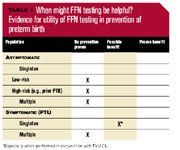MFM Consult: Fetal fibronectin: When should you screen patients?
If a patient with a prior spontaneous preterm birth presents at 24 weeks, should you test fibronectin levels to determine her risk of another preterm delivery?
Q. A 23-year-old gravida 2 with a prior spontaneous preterm birth presents at 24 weeks for a routine visit. She has no symptoms of preterm labor. Should you do fetal fibronectin screening to assess her risk of recurrent preterm birth?
A. Fetal fibronectin (FFN) is a glycoprotein located between the chorion and decidua that is absent or found only in low levels in cervicovaginal secretions between 22 and 34 weeks. A high level (≥50 ng/mL) of FFN in the cervicovaginal secretions at or after 22 weeks increases the risk of spontaneous preterm birth (PTB). The overall sensitivity and specificity of FFN for PTB are about 56% and 84%, respectively, but these vary according to gestational age at collection, the population studied, and whether single or repeated screens are performed.1 The positive and negative predictive values also vary according to the incidence of PTB in the population. The positive predictive value of a positive FFN screen varies from about 9% to 46%, and the negative predictive value is often greater than 90%.1 Even at 13 to 22 weeks, a FFN level elevated above the 90th percentile increases the risk of a subsequent spontaneous PTB two- to threefold, but the usefulness of quantitative FFN requires further research validation prior to incorporation into clinical practice.
FFN is a screening test, and as such only adjusts the risk of PTB. For a screening test such as FFN to be clinically useful, it must lead to a potentially effective intervention (monitoring or treatment that has been demonstrated to improve outcomes), or to have adequate negative predictive value to allow the caregiver to forgo such interventions. Currently there is no evidence from randomized trials to suggest that FFN is of benefit in the management of asymptomatic women with a prior PTB (or for other at-risk populations, such as twin gestations). Antibiotics, the only intervention that has been studied in this manner for women with a positive FFN, has not been shown to prevent PTB in asymptomatic women in two trials.2,3 Further, in interventional trials, commonly used prophylactic measures such as bed rest and tocolysis have not benefited women in the absence of FFN screening, and should not be assumed to be effective for women with a positive test until this is confirmed by clinical trials.

What about FFN screening for symptomatic women?
FFN screening may be more useful in managing symptomatic women with suspected preterm labor at or before 34 weeks' gestation (Table 1). For these women, a recent meta-analysis of randomized trials found that knowledge of the FFN result is associated with lower incidence of PTB.4 This benefit was attributed in particular to one trial in which FFN was used in conjunction with transvaginal ultrasound (TVU) assessment of cervical length (CL).5 Half of the participants with threatened preterm labor were randomly assigned to the protocol. Admission, steroids for fetal lung maturity, and tocolysis were recommended for patients with either CL below 20 mm or CL between 20 and 29 mm and a positive FFN. For a patient with CL of 20 to 29 mm and a negative FFN, consider discharge or prolonged observation; if contractions persist, consider repeating CL and management at the clinician's discretion. The protocol recommended discharge when CL is at or above 30 mm.
This trial found a decrease in PTB from 36% to 13% for those who had TVU CL and FFN results available to them despite the fact that women with a CL of 30 mm or more, or a CL of 20 to 29 mm with negative FFN, were not admitted to the hospital. In this study all women who delivered before 34 weeks were able to receive antenatal corticosteroids.5 It is important to emphasize that this evidence is from just one small trial, which has not yet been replicated. It is also still unclear which intervention(s) are most beneficial once a positive FFN result is obtained.
FFN screening should not be repeated after a positive result. Even if the subsequent test is negative, the risk of PTB remains elevated.6 Furthermore, no prospective trials have been performed to evaluate interventions based on repeated FFN screening after a positive test.
